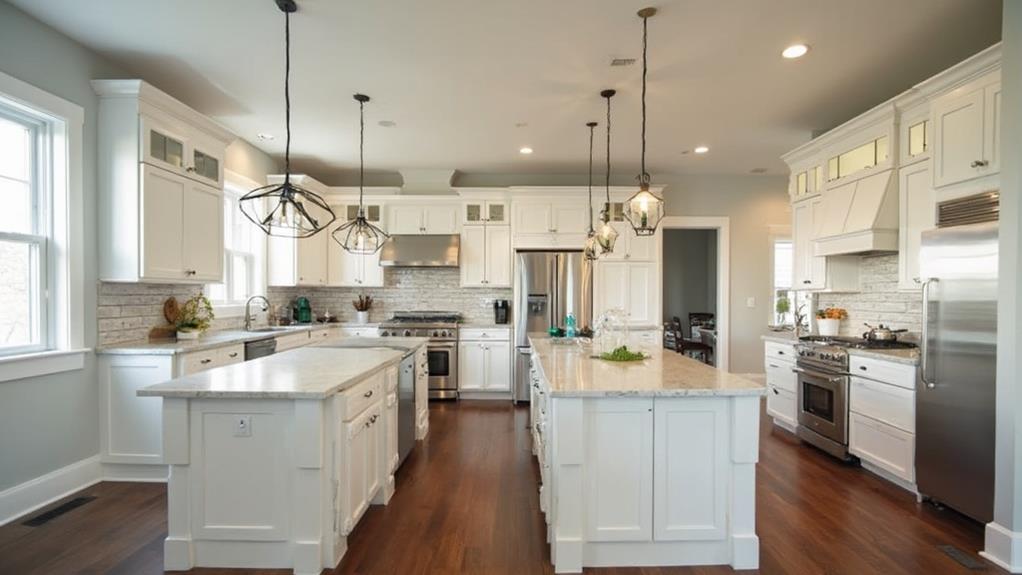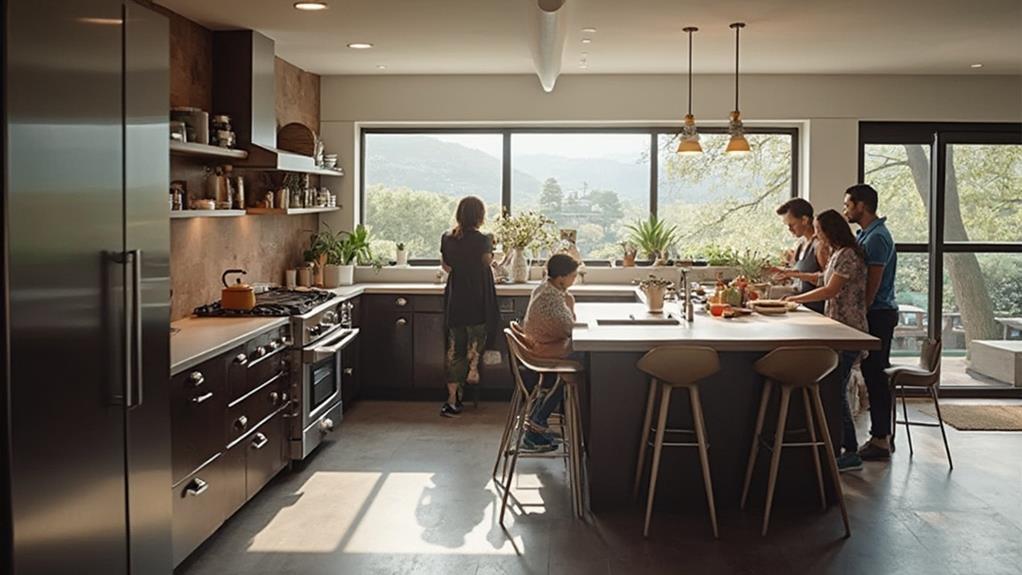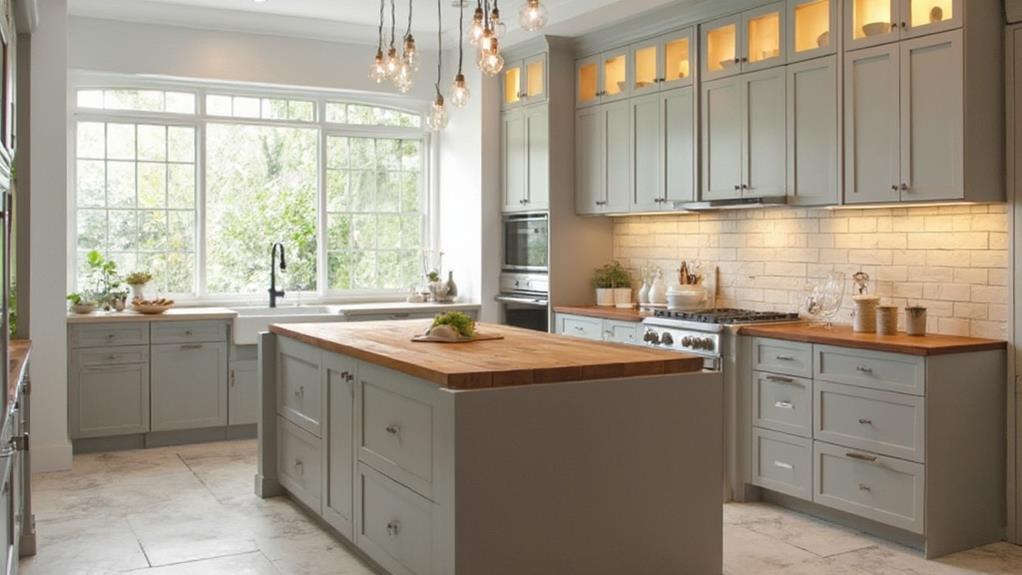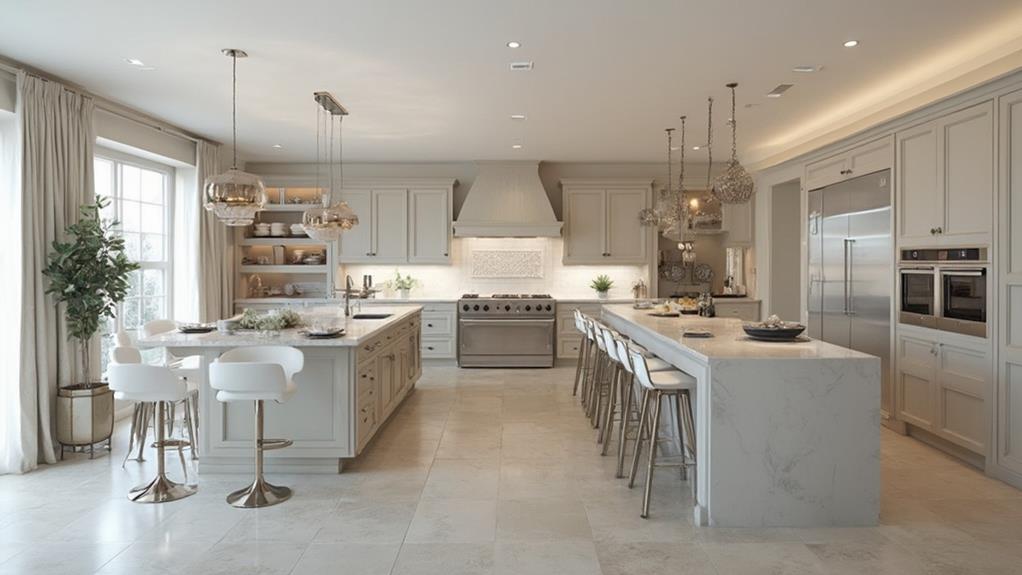When choosing between a kitchen island and peninsula, consider your space and needs. Islands offer 360-degree access, more storage, and versatile design options, but they require more room and can create traffic bottlenecks. Peninsulas are space-efficient, streamline traffic flow, and provide intimate seating, but they're less flexible in design and placement. Islands excel for entertaining and multi-person meal prep, while peninsulas work well for smaller families and casual dining. Both can add valuable counter space and storage. Your kitchen's layout, size, and your lifestyle will ultimately determine which option suits you best. Exploring the specifics of each feature will help you make an informed decision.
Space Requirements

When considering kitchen islands versus peninsulas, space requirements play a crucial role in your decision. Kitchen islands typically need more space, as they're freestanding structures that require clearance on all sides. You'll want at least 36 inches of walkway around the island, with 42-48 inches being ideal for a comfortable workspace. This means you'll need a kitchen that's at least 12-13 feet wide to accommodate an island effectively.
Peninsulas, on the other hand, are more space-efficient. They're connected to a wall on one side, which reduces the required clearance. You'll still need 36-48 inches of walkway on the open sides, but the overall footprint is smaller. This makes peninsulas a better choice for kitchens with limited square footage or narrow layouts.
Consider your kitchen's dimensions carefully. If you have a spacious kitchen, an island can provide a central gathering spot and extra workspace. For smaller or galley-style kitchens, a peninsula might be the better option, offering additional counter space without overwhelming the room. Remember, it's not just about fitting the structure in; you need to ensure there's enough space to move and work comfortably.
Traffic Flow Considerations
How well does your kitchen layout accommodate movement? When considering kitchen islands versus peninsulas, traffic flow is a crucial factor. Islands offer 360-degree access, allowing multiple people to work simultaneously without bumping into each other. You'll find it easier to move between different work zones, creating an efficient workflow.
However, if your kitchen is narrow, an island might create bottlenecks, forcing you to squeeze past it to reach other areas.
Peninsulas, on the other hand, can streamline traffic in L-shaped or U-shaped kitchens. They're excellent for separating the cooking area from the living space, guiding foot traffic along a specific path. You'll often find that peninsulas create a natural flow between the kitchen and dining area. But be cautious: a poorly placed peninsula can obstruct movement between key work zones.
When deciding between the two, consider your family's habits. Do you often have multiple cooks in the kitchen? An island might be best. Do you prefer a more defined separation between cooking and living areas? A peninsula could be your ideal choice. Ultimately, the best option is the one that allows for smooth, unobstructed movement throughout your kitchen.
Seating and Social Interaction

Both kitchen islands and peninsulas offer unique opportunities for seating and social interaction. Islands provide 360-degree access, allowing you to place stools on multiple sides. This creates a more inclusive atmosphere, perfect for parties or family gatherings. You can easily chat with guests while preparing meals, making the kitchen a social hub.
Peninsulas, while offering less seating space, create a more intimate setting. They're ideal for smaller families or couples who want a cozy breakfast nook. You'll find that peninsulas naturally separate the kitchen from adjacent living areas, which can be beneficial if you prefer a degree of privacy while cooking.
When choosing between the two, consider your lifestyle and entertaining habits. If you frequently host large gatherings, an island's versatility might be your best bet. You can use it as a buffet, a drink station, or extra prep space. Peninsulas, however, work well for casual dining and homework sessions, as they often connect to existing countertops, creating a seamless flow. Ultimately, your choice should reflect how you plan to use the space and interact with family and guests in your kitchen.
Storage and Functionality
Beyond their social benefits, kitchen islands and peninsulas offer distinct advantages in terms of storage and functionality. Islands typically provide more storage options, with cabinets and drawers accessible from all sides. You'll find it easier to organize pots, pans, and small appliances in an island's ample space. Many islands also incorporate open shelving, allowing you to display cookbooks or decorative items.
Peninsulas, while offering less overall storage, can be more efficient in smaller kitchens. They're often designed with built-in cabinets that seamlessly connect to existing cabinetry, maximizing corner spaces. You'll appreciate how peninsulas can house appliances like dishwashers or wine coolers without sacrificing counter space.
Both options enhance functionality by providing additional work surfaces. Islands are versatile, allowing you to prep food, cook, and clean in one centralized area. They're ideal for installing cooktops or sinks, creating an efficient work triangle. Peninsulas excel at defining kitchen boundaries and can serve as a natural divider between cooking and living areas. You'll find that peninsulas are particularly useful for creating a breakfast bar or homework station, doubling as both a functional and transitional space in your home.
Design Flexibility

When it comes to design flexibility, kitchen islands reign supreme. You can place them virtually anywhere in your kitchen, allowing for various layouts and traffic flow options. Islands come in countless shapes, sizes, and styles, making it easy to find one that fits your specific needs and aesthetic preferences. You'll also have the freedom to customize your island with features like built-in appliances, sinks, or seating areas.
Peninsulas, on the other hand, offer less flexibility in terms of placement and design. They're typically attached to a wall or existing cabinetry, limiting your layout options. However, peninsulas can be an excellent choice for smaller kitchens or spaces where an island might obstruct traffic flow. They can also serve as a natural divider between the kitchen and adjacent living areas.
Both options allow for customization in terms of materials, colors, and finishes. You can match them to your existing cabinetry or use contrasting elements to create a focal point. While islands offer more design possibilities, don't discount the potential of a well-designed peninsula to enhance your kitchen's functionality and aesthetics.
Cost Comparison
At first glance, kitchen islands may seem like the pricier option compared to peninsulas. However, the cost difference isn't always significant, and several factors can influence the final price tag.
Islands typically require more materials, as they're freestanding structures. You'll need additional cabinetry, countertop surface, and potentially extra plumbing or electrical work if you're adding a sink or appliances. This can drive up costs. Peninsulas, on the other hand, are extensions of existing countertops and cabinets, which may reduce material expenses.
But don't dismiss islands based on cost alone. They can add substantial value to your home, potentially offering a better return on investment. Peninsulas, while generally less expensive, mightn't boost your home's value as much.
Consider your budget and long-term goals when deciding. If you're working with limited funds, a peninsula could be a smart choice. But if you can stretch your budget, an island's versatility and potential value increase might justify the extra expense. Remember, costs can vary widely based on materials, size, and features, so get detailed quotes for both options before making your decision.
Conclusion
Weighing islands against peninsulas is like navigating a culinary crossroads. You've explored the landscape of kitchen design, from space-saving strategies to social butterflies' gathering spots. As you chart your course, remember: there's no one-size-fits-all solution. Your perfect kitchen may be an island paradise or a peninsula haven. Trust your instincts, embrace your style, and create a space that's the heart of your home. The kitchen of your dreams is just around the corner!

